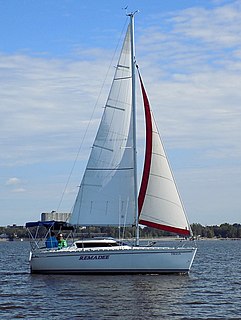Related Research Articles

Hobie Cat is a company that manufactures sailing catamarans, surfboards, sailboats, kayaks, stand-up paddle boards, and pedalboards as the Hobie Cat Company. It was founded in 1961 by Hobart Alter, who originally manufactured surfboards. Its line of products has included more than twenty sailing craft, plus a variety of other watercraft.

A trailer sailer is a type of sailboat that has been designed to be easily transported using a boat trailer towed by an automobile. They are generally larger than a sailing dinghy. Trailer sailers include day sailers and small cabin cruisers, suitable for living on.

The Tonic 23 is a French trailerable sailboat, that was designed by Philippe Harlé as a coastal cruiser and first built in 1985.
The Merit 25 is an American trailerable sailboat that was designed by Paul Yates as a Midget Ocean Racing Club (MORC) racer and first built in 1978.
The Freedom 25 is an American sailboat that was designed by Gary Hoyt as a single-handed racer-cruiser and first built in 1980.
The San Juan 33S is an American sailboat that was designed by David Pedrick as racer and first built in 1981.
The Bristol Caravel 22, sometimes called the Bristol 22 Caravel, Sailstar Caravel, or just the Caravel 22, is an American trailerable sailboat that was designed by Halsey Chase Herreshoff as a cruiser and first built in 1968. It is named for the class of sailing ship.
The Dehler 22 is a West German trailerable sailboat that was designed by E. G. van de Stadt and first built in 1983. It is van de Stadt's design number 374.
The Dehler 25 is a German trailerable sailboat that was designed by E. G. van de Stadt as a cruiser and first built in 1984.
The Elite 25, also called the Feeling 720 NV, is a French trailerable sailboat that was designed by Michel Joubert of Joubert-Nivelt as a cruiser and first built in 1982.
The ETAP 23iL is a Belgian trailerable sailboat that was designed by Jacques de Ridder as a cruiser and first built in 1994.
The ETAP 26 is a Belgian trailerable sailboat that was designed by E. G. van de Stadt as a cruiser and first built in 1982.
The Freedom 21 is an American trailerable sailboat that was designed by Gary Hoyt and first built in 1982. It was available as a catboat or sloop rig.
The Freedom 24 is an American trailerable sailboat that was designed by William H. Tripp, III as a racer-cruiser and first built in 1994.
The Grampian 23 is a Canadian trailerable sailboat that was designed by Alex McGruer as a cruiser and first built in 1971.

The Holder 20 is an American trailerable planing sailboat that was designed by Ron Holder, in collaboration with sailmaker Dave Ulmann, as a one design racer and first built in 1980.
The Eolia 25 is a French trailerable sailboat that was designed by Philippe Briand as a coastal cruiser and first built in 1983.
The Balboa 26 is an American trailerable sailboat that was designed by Lyle C. Hess as cruiser and first built in 1969.
The Venture 21 is an American trailerable sailboat that was designed by Roger MacGregor as a racer-cruiser and first built in 1966.
The Jeanneau Flirt is a French trailerable sailboat that was designed by the Jeanneau Design Office, as a pocket cruiser and first built in 1976.
References
- 1 2 3 4 5 McArthur, Bruce (2019). "Hobie 33 sailboat". sailboatdata.com. Archived from the original on 5 December 2019. Retrieved 5 December 2019.
- ↑ McArthur, Bruce (2019). "Hobie Alter". sailboatdata.com. Archived from the original on 1 July 2019. Retrieved 5 December 2019.
- 1 2 3 4 5 6 7 8 9 Sherwood, Richard M.: A Field Guide to Sailboats of North America, Second Edition, pages 256-257. Houghton Mifflin Company, 1994. ISBN 0-395-65239-1
- 1 2 3 4 "Hobie 33". Boat-Specs.com. 2019. Archived from the original on 5 December 2019. Retrieved 5 December 2019.
- ↑ McArthur, Bruce (2019). "Hobie Cat". sailboatdata.com. Archived from the original on 1 July 2019. Retrieved 5 December 2019.